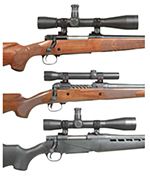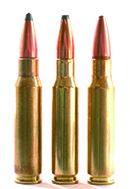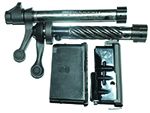The 308 cartridge lends itself to being chambered in light rifles. The cartridge performs quite well on deer-size animals, and also it’s lots of fun to plink with, given the easy accessibility to inexpensive ammo. For this test we looked at three light 308s. These were a Winchester Model 70 Featherweight Compact ($880), a Savage 11/111 Lightweight Hunter ($899), and a Mossberg 4X4 No. 27656, $471). We were unable to obtain a walnut-stocked Mossberg for a better comparison, but they are offered at $624, quite a jump from the black-plastic-stocked test rifle.
We tested with Remington Core-Lokt 150-grain, Winchester Super X 180-grain, and with Remington Core-Lokt 180-grain loads. Here’s what we found.

Winchester M70 Featherweight Compact SA 535126220 308 Winchester, $880
This was a very attractive rifle. The wood was of excellent quality with some pleasant fancy grain. The checkering was near perfection, at least as good as our resident gunsmith can do by hand. The checkering pattern was also very attractive, with swirls, lines, and a pleasing border pattern. The rifle’s bluing also was excellent. The floorplate was steel, though the trigger guard and attachment metal were aluminum. There was a plastic grip cap and a thick, comfortable Pachmayr Decelerator pad. The forend had a Schnabel shape that we all liked.
The bolt was the old controlled-feed type that Winchester had in days of yore, complete with cone-shaped breech. In addition, the bolt retained the tiny lip under its forward edge, a device developed during the post-’64 days of this rifle to prevent bolt binding. Bolt motion was very slick. Takedown of the bolt was just like all Winchesters, cock the action, put the safety on half way, pull the bolt, press the little button on the side of the bolt sleeve, unscrew it and out come the guts. This was as close to the old classic pre-’64 Winchester Model 70 as we’ve seen, with three exceptions. One, the metal polish and finishing were the best we’ve ever seen on a Model 70 of any vintage. Two, the stock design, finish and checkering were far better than in the old days. And three, the barrel was free floated.
The magazine held five rounds, and they could be removed by opening the floorplate by pressing a button in front of the trigger guard, where it can’t be bumped by the trigger finger in recoil. The stock had no cheekpiece nor hump, but was straight on top, parallel to the bore. We found it to be very comfortable. The wrist was just the right size, we thought. The adjustable trigger was set to 3.8 pounds. This trigger is a new design for Winchester, but is at least as good as the old one, in our experience, except that there seems to be a large hole around the trigger itself that could let dirt get inside. The trigger had no creep, and we left its adjustments alone. One nice touch that we suspect most shooters might not notice is that the tiny screws that filled the scope-mounting holes were all lined up, slots exactly fore and aft.

The drilled and tapped mounting holes exactly matched the Weaver bases we had formerly used on a pre-’64 Model 70 action. We mounted our 12X Leupold on the Winchester and took the rifle to the range.
We began our test with Remington’s Core-Lokt 180-grain ammunition. Our first three-shot group at 100 yards went into 1.2 inches. Our next went into 1.5, and the third into 4.1. What was wrong? We had cleaned the barrel thoroughly after three shots, and did so again after a few more. The barrel was thoroughly clean, yet we got these horrid groups. We checked all the scope and action screws, and all were tight. The scope, a 12X Leupold, had served us very well as a test vehicle for several years. We fired one more group and got a flyer several inches out. We then changed scopes to our costly Leupold Mark 4 16×40 LR/T scope, which is nearly new and had been thoroughly vetted on several rifles recently. Our groups got no better. Was it a bad rifle?
We ran a piece of paper along the barrel to check the free-floating bedding, and all was well. We know that light, free-floated barrels can be finicky about bullet weight and velocity, but before we shot a different-weight bullet, we tried the Winchester 180-grain Super X ammo. Our first group was 0.9 inch. The biggest group with that ammo was 1.7 inches. Clearly, the Winchester rifle liked the Winchester ammo.
We had noted vast variations in the velocity of our box of Remington ammo, ranging from 2510 to 2650 fps. One of the primers was even a different color from the others, though its velocity was in the same broad ballpark. We ultimately concluded it was a bad lot of ammo. Our Remington Core-Lokt 150-grain ammo went into 1.7 inches on average. We wanted to try our old standby Federal Match ammo but have not been able to obtain any more of this for some time. We’re in process of developing our own handloaded match ammo for 308s, but it’s not yet ready for prime time. We ultimately concluded the accuracy was there, and the right ammo would give perfectly acceptable results. It might be noted that tests have been done with slim, free-floated barrels by fully bedding them with upward pressure on the forend, and this has resulted in overall better accuracy with a greater variety of bullet weights. Keep that in mind if you buy one of these.

We might add, the Winchester Model 70 Owner’s Manual can be downloaded from the Winchester website (Winchesterguns.com).
Our Team Said: We very much liked the little Winchester 308. It was not as light as some 308s we’ve seen, notably by Kimber, but we thought it was mighty reasonable for a rifle of the 308’s power. The metalwork was superlative, as was the stock finish and overall wood treatment. The quality of the walnut stock wood itself was a big cut above plain. It had some excellent figure that would make its owner proud. We liked the Pachmayr recoil pad. Feed and ejection were flawless. In fact, we could not fault this rifle. It shot well enough, given good ammo. If we didn’t already have all the 308s we need, we’d own this one, but would get it glass-bedded immediately, and of course would fit a suitable 4X scope on it instead of our huge mil-spec test scope.
Savage 11/111 Lightweight Hunter No. 19209 308 Winchester, $899
We’ve never seen quite as light a 308 rifle as the Savage, though the Kimber might come close. This one was easy to hold with one hand at arm’s length, though we didn’t try shooting it that way. The rifle came full of holes for lightness, and with a twisty-looking bolt, which also cut weight. The rifle had an empty weight, unscoped, of 5.8 pounds. The wood stock was a lesson in how to cut a rifle’s weight, as was the very slim barrel. The wood had vent holes in the bottom of the forend, and it was easy to see lots of the wood inside had been removed. It had two crosspins to avoid splitting. The 20-inch barrel tapered to 0.564-inch diameter at the muzzle. The bottom metal was matte-black aluminum, as was the base of the magazine. The stock had a good Pachmayr Decelerator recoil pad, nicely fitted. The walnut was well checkered in four panels, and there were sling studs fore and aft. There were no provisions for iron sights.

The action also had cuts in it to lose weight. The cuts, which didn’t compromise the integrity of the lockup, were along the left rail, and around the rear bridge. The forward bridge had dual opposing gas ports. The rifle had a detachable magazine that held three rounds. The bolt fluting was stunning, to say the least. The exterior surface of the bolt body was milled with eight grooves 1⁄8-inch wide, cut in a spiral pattern. This took off weight, gave a place for oil to stick, and looked great because the bottoms of the grooves were blued while the bolt body was polished white. Removing the bolt from the rifle required opening the bolt, pressing the trigger, and then pressing a button in front of the trigger guard to let the bolt out. Reinserting the bolt required pressing the trigger again. The rifle had a three-position tang safety, all the way back to lock, midway to work the bolt, and forward to fire. We liked that safety, its position and quiet operation. The rifle’s trigger was Savage’s AccuTrigger, the best in the business. It was set at just under 3 pounds. The bolt had a recessed face, sliding extractor, and a plunger ejector. Bolt travel was slick and smooth.
The Savage 11/111 also came with Weaver bases attached, which we thought was a mighty nice touch because we like them and use them all the time for testing rifles. This simplified our scope mounting. We had two scopes set up to drop onto this rifle, one a 36-power Lyman target scope, and the other the little 2.5 Weaver we tried on the 375 H&H Winchester Model 70 in a recent test. The little Weaver was our pick, and on it went. We can’t recall a rifle that we were more eager to shoot than this one.
On the range, we found the rifle to be easy to shoot and slick to handle, though the heavier bullets did give us some felt recoil. The good recoil pad made sure the rifle never hurt us. While the dedicated bench experimenter or fun shooter might want a heavier rifle, we thought that for a shot or two at game, this rifle is plenty heavy enough for its power. We found we could load the magazine with it in place, as we could the Mossberg’s magazine, but both were far easier to load when removed from the rifle. The Savage held three in the magazine, and we could load one in the chamber on top of that.
Our Team Said: We found the Savage 11/111 to be a mighty pleasant rifle in all ways. It was necessary to make sure the mag was securely seated and latched into the rifle. Feeding was slick and smooth, as was ejection. The fine trigger made testing this little 308 a happy experience. The rifle gave plenty of accuracy with even the heaviest bullets we tried, so we found the test target that came with the rifle, showing a small group with match ammo, was justified. Although the Winchester was prettier, this one was half a pound lighter. We’d buy this one.
Mossberg 4X4 No. 27656 308 Winchester, $471
While its stock would never win a beauty contest, the Mossberg was a solid rifle, we thought. The matte-blued metalwork included a fluted barrel, at least for the forward foot of it. It had holes in the stock along the side that also served to give some minimal traction to the forward hand (there was no checkering), a thick recoil pad, and molded-in sling swivel holes. The 4X4 had a detachable, light, plastic magazine. It fitted securely into the stock and held five rounds. Like that of the Savage, it could be loaded in place. The stock had various panels that made it look like it was assembled from many parts. The stock had a leather-like surface fitted where the shooter’s hands went. This gave noticeably warmer surfaces under the hands. However, we found these surfaces to be slippery on the bench. We could not get a good, secure grip on the forend.

The trigger guard was polymer. To our surprise the rifle had an adjustable trigger. Its trigger resembled Savage’s AccuTrigger, but was a different design, so far as we could tell. Like the Savage AccuTrigger, a little safety slide in the trigger kept the rifle from going off until the finger was placed directly on it. This is much like the Glock trigger. With the little slide depressed, the trigger pull was a stunning, clean break of 2.9 pounds. Nice! We found no need to mess with the trigger adjustments.

If the trigger is somehow pressed rearward without the safety slide being depressed, it’s impossible to fire the rifle until the bolt handle is lifted and relocked. This is exactly what happens with the AccuTrigger. Mossberg calls it the LBA trigger, for Lightning Bolt Action. No matter what you call ‘em, we guarantee you’ll love the triggers on both the Savage or the Mossberg. And that of the Winchester ain’t bad either.
The Mossberg 4X4 had a 24-inch barrel. The rifle was lighter than most 308s but not anywhere near as light as the Savage. The 4X4 weighed 6.5 pounds empty. The 4X4 came with Weaver bases, as had the Savage. Like the Savage, the Mossberg had a recessed bolt face, sliding extractor and plunger ejector. The bolt was slimmer than that of the Savage, but weighed more. Bolt removal was by pressing a button on the left rear of the action, similar to a Model 70 Winchester. The free travel of the bolt was again mighty slick. There was a lever-type safety on the right rear corner of the action. It prevented the rifle from firing but did not lock the bolt closed, so there was no need for a third position. Forward was the firing position.
We installed our Leupold Mark 4 16×40 mil-spec scope on the Weaver bases and took the Mossberg to the range. Although the rifle was a pound heavier than the Savage, and had a scope that added lots of weight, we still had trouble keeping the forend down with our forward hand. The stock was so slippery it jumped out of our forward hand on recoil. We used Elmer Keith’s proven technique on the machine rest, gripping the forend hard and bedding our hand into the rest. With lots of rearward tension on the stock this cuts felt recoil a whole bunch and gives the best control we’ve found on rifles that have significant kick. These light 308s had that.
Our groups were somewhat disappointing in that the Mossberg was not a tack driver. We cleaned the barrel and double checked the tightness of all the screws, yet our best group with all three types of ammo was 1.9 inches with the 150-grain Remington Core-Lokt ammo. Groups with the 180-grain ammo were from just under 3 to just over 4 inches. That’s probably enough accuracy for most hunting situations, but we’d like better results.
Our Team Said: We were not quite happy with the Mossberg. It lacked charming looks, and while we liked the warmth provided to a cold stock by the stuff that wrapped the forend and wrist, it didn’t give enough traction for us. We’d prefer checkered plastic over the stuff that was on there.The accuracy was just not there to our satisfaction, at least compared to the other rifles. Although the price was right, we thought most shooters would be far happier with the Savage or the Winchester at nearly twice the price.




























